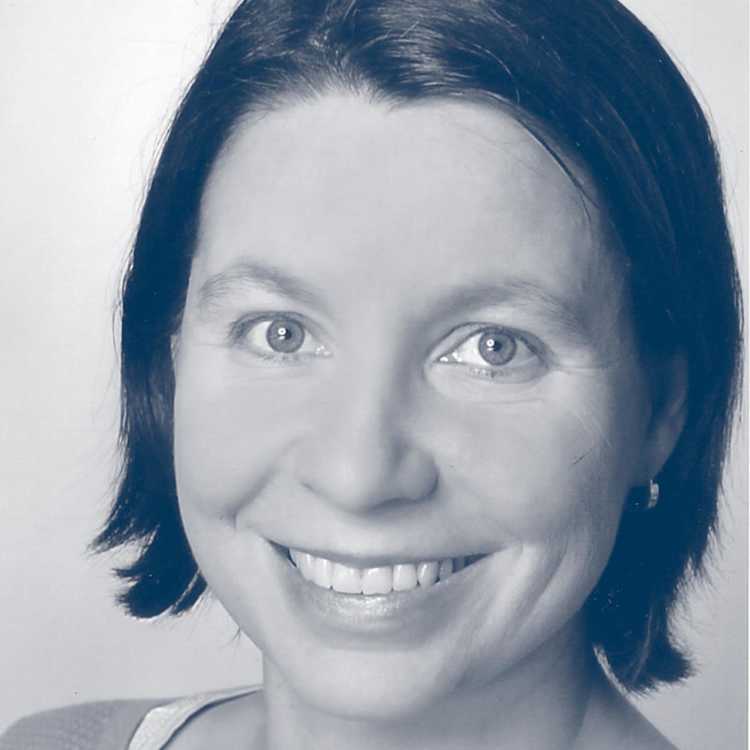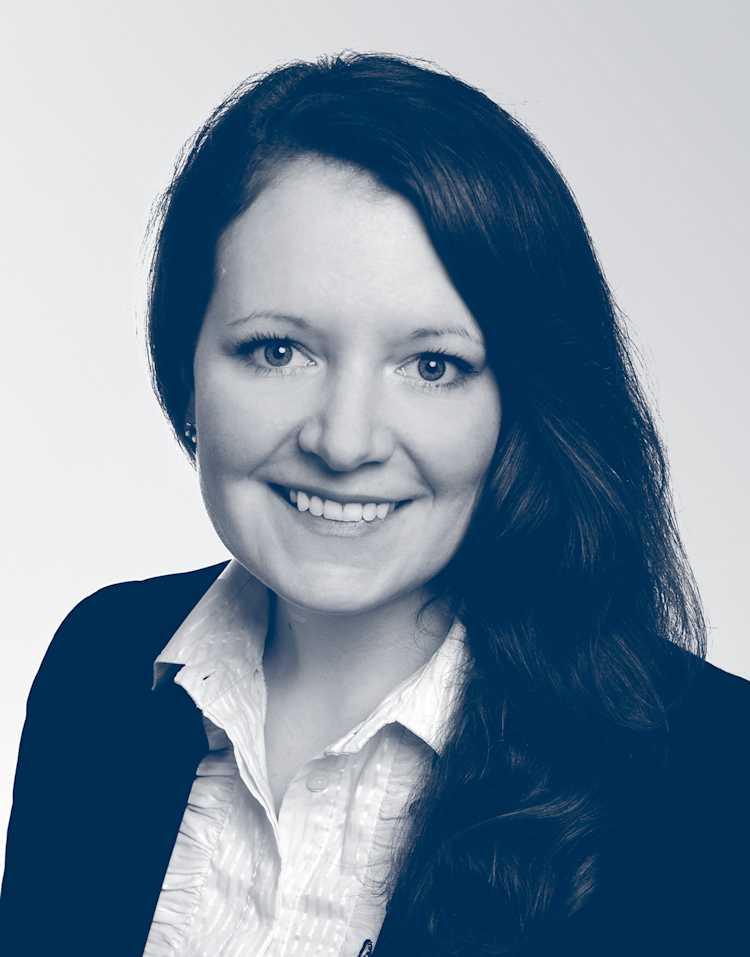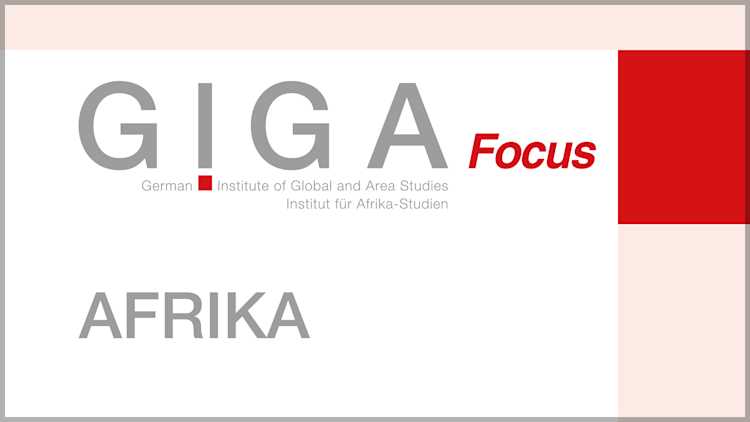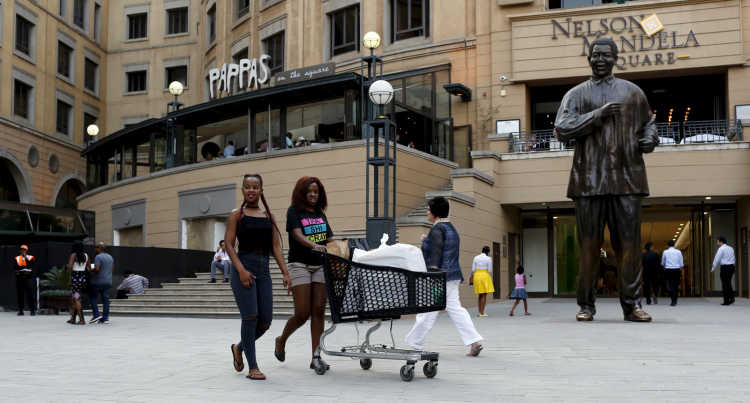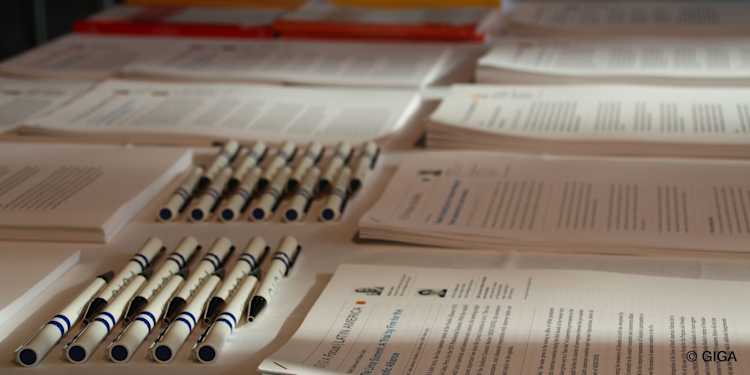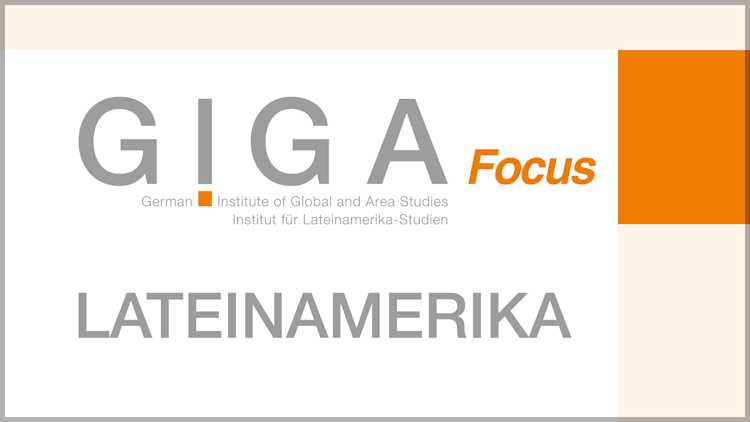- Startseite
- Publikationen
- GIGA Focus
- Africa’s New Middle Class: Fact and Fiction of Its Transformative Power
GIGA Focus Afrika
Afrikas neue Mittelschicht: Fakten und Fiktionen ihrer transformativen Kraft
Nummer 1 | 2016 | ISSN: 1862-3603
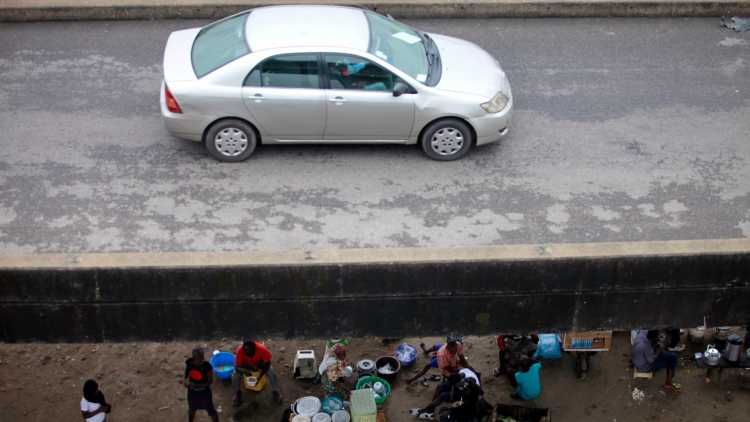
Afrikas neue Mittelschicht ist zu einem zentralen Thema in der Entwicklungsdebatte geworden. Sie gilt als Garant für Wirtschaftswachstum, politische Stabilität und demokratische Konsolidierung. Viele der jüngsten (teilweise erfolgreichen) Proteste und Versuche, alternde, sich an die Macht klammernde Präsidenten aus dem Amt zu jagen, wurden in den Medien mit dem Aufstieg einer afrikanischen Mittelschicht in Verbindung gebracht.
Nach zehn Jahren starken Wachstums weitgehend ohne die Entstehung neuer Arbeitsplätze stehen die Angehörigen der aufstrebenden afrikanischen Mittelschicht größtenteils immer noch am Rand zur Armut. Es herrscht zunehmend Einigkeit darüber, dass Größe und Kaufkraft afrikanischer Verbrauchermärkte übertrieben dargestellt worden sind.
Auch können steigende Einkommen und sinkende Armutsraten nicht ohne Weiteres mit der Entstehung einer politisch bewussten Mittelschicht gleichgesetzt werden, die Demokratie und gute Regierungsführung unterstützt.
Die künftige wirtschaftliche und politische Transformationskraft der afrikanischen Mittelschichten hängt ab von a) ihrem Potenzial zur Herausbildung einer gemeinsamen Klassenidentität über ethnische und historische Bande hinweg; b) ihrer wirtschaftlichen Unabhängigkeit von staatlicher Unterstützung; c) dem politischen Engagement ihrer höher gebildeten Angehörigen; und c) der Vereinbarkeit ihrer politischen Eigeninteressen mit den Bedürfnissen der breiten Bevölkerung.
Die Schaffung von Arbeitsplätzen und die Verringerung fortbestehender Ungleichheiten bleiben zentrale Herausforderungen, denen sich Afrikas Regierungen stellen müssen, um ein Abrutschen der unteren Mittelschichten zurück in die Armut zu verhindern.
Fazit
Afrikas neue Mittelschicht ist kein homogener Akteur, sondern eher ein Mosaik verschiedener Gruppen. Am unteren Rand der Mittelschicht lässt sich eine politisch bewusste Gruppe junger, städtischer Bürger identifizieren, die sich immer lauter artikuliert und deren politische Aktivitäten hauptsächlich durch Frustration angetrieben werden. Angehörige der Mittelschicht am oberen Rand sind demgegenüber politisch eher inaktiv und haben ein Eigeninteresse an der Aufrechterhaltung des Status Quo; die großen Hoffnungen auf ihr Reformpotenzial könnten sich als ungerechtfertigt erweisen.
Africa’s Middle-Class Story: From Shopping Malls to Democracy
The wave of upbeat stories about Africa’s accelerating economic growth in the years after 2000 has been excitedly embraced by the business community, which is seeking new investment opportunities in a global landscape unsettled by financial turbulence and stagnation in Western markets. More than a few management consultancies and fund managers have celebrated the continent as the “new frontier.” Multinational companies have ventured into the African market with large investments, counting on a transition of many African economies from resource exporters to consumer markets. Stirred up by an influential report from the African Development Bank (Ncube et al. 2011), Africa’s rising middle class has been portrayed as a central protagonist in this optimistic narrative.
However, since the end of the commodity boom, Africa’s new middle class consumers have decreased spending. This has seen critical opinions expressed with the same vehemence as those earlier optimistic views. Numerous newspapers articles and media reports have jumped on the examples of Nestlé and Barclays, which have turned their backs on Africa after disappointing returns on major investments.
Beyond viewing Africa’s new middle class as a prospective engine of economic growth (through its potential to shift consumption and production patterns), some analysts have fostered the idea that it could also become a bastion of political stability, progress, and democratic consolidation across the continent. In line with the US political sociologist Barrington Moore’s famous statement “No bourgeoisie, no democracy,” Africa’s middle class voters are expected to promote democratic maturity and good governance. Rather than simply occupying a space in the income distribution in society, they are seen as – in the words of the African Development Bank’s former chief economist, Mthuli Ncube – the “drivers of democracy” throughout the region. This expectation rests not only on the fact that educational attainment is now higher in the region, but also on the knowledge that increased integration into the global communication landscape is occurring via use of mobile phones, the Internet, and social media networks. The mobile phone, for instance, “is creating a politically conscious class” in Africa according to Citigroup’s Africa economist, David Cowan (Fletcher 2013).
However, an increasing number of analysts caution that the springing up of shopping malls, European-style coffee shops, movie theatres, and new housing complexes in a number of African cities should not be equated with the rise of a growing, politically conscious middle class that is safeguarding democracy and individual rights and condemning corruption. While there is now increasing evidence that estimations of the size and economic potential of Africa’s new middle class have been exaggerated, knowledge on the political values, attitudes, and behaviours of these new „non-poor“ is only just beginning to evolve. We are yet to determine whether the African middle class shares particular values or whether it can become the harbinger for democratic consolidation and gradual political change. In the following we will shed light on these questions after clarifying who is actually understood to be middle class in Africa.
Who Is Africa’s Middle Class?
At the core of the opposing views and expectations of the potential of Africa’s middle class is a long-standing debate on what constitutes the middle class. As already noted by Aristotle, its members should be somewhere in the middle, which typically means they should be neither rich nor poor. However, to derive a comprehensive measure of social class, researchers ideally would like to have information on a broad range of factors. These may include someone’s family background, education, job, and wage earnings as well as whether she lives in a proper house, owns a car, has a mobile phone, or even just perceives herself as a member of the middle class. Most class analyses draw on the assumption that the accordingly identified social positions are somehow linked to shared interests, values, and behaviours.
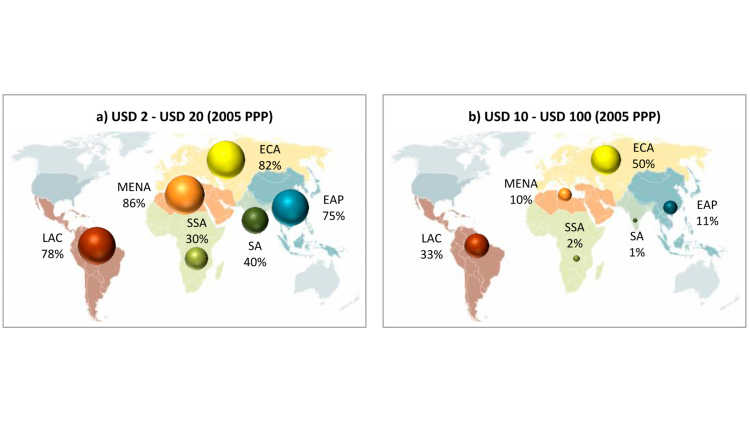
To simplify matters and due to a frequent lack of respective data, however, many studies reduce class analysis to a monetary indicator that approximates a person’s social status. Most commonly used are absolute thresholds that (rather arbitrarily) locate the middle class within a particular income or expenditure range, which eases comparisons across countries. Certainly, where one sets these thresholds has qualitatively different implications. This has seen a heated debate emerge, especially regarding the lower cut-off point that separates the poor from the middle class. Although most experts will agree that (relative) poverty in Africa has fallen over the past two decades, the important question here is whether all those who are no longer starving automatically enter the middle class. Some of the dominant definitions in fact do suggest so and imply that someone living on the equivalent of USD 1.99 a day (mostly measured in purchasing power parities) would still be considered poor, while just one additional cent would push the same person into the middle class.
Most influential with regard to Africa, the African Development Bank (AfDB) released a report in 2011 suggesting three subdivisions of the African middle class: “floating” (USD 2–4), “lower middle” (USD 4–10), and “upper middle” (USD 10–20). According to this definition, almost every third person was considered middle class in Africa. Other approaches argue that only those people who are at a reasonably low risk of falling back into poverty should be counted as middle class and thus advocate a higher lower cut-off of that lies between USD 4 and USD 10 and an upper cut-off up to USD 100 (Kharas 2010; Birdsall 2015).
Using the World Bank’s PovcalNet database, Figure 1 shows that while the size of Africa’s middle class looks rather impressive under the AfDB definition, it almost vanishes when more demanding criteria are applied. Also sobering is the geographical dispersion: most of the African upper middle class (those spending above USD 10 a day) is based in the North of the continent (10 per cent of the global middle class versus 2 per cent in the South). This does not bode well for the narrative of a new consumption frontier south of the Sahara.
Adding future concerns to this pessimistic present picture, Organisation for Economic Co-operation and Development (OECD) predictions suggest that the region’s share in the global middle class will remain unchangeably negligible up to 2030 (Kharas 2010). Again based on PovcalNet data, Figure 2 reveals that past trends in the size of the region’s middle class justify the upbeat expectations of a future middle-class boom in sub-Saharan Africa only if those who just jumped the poverty line are taken into account.
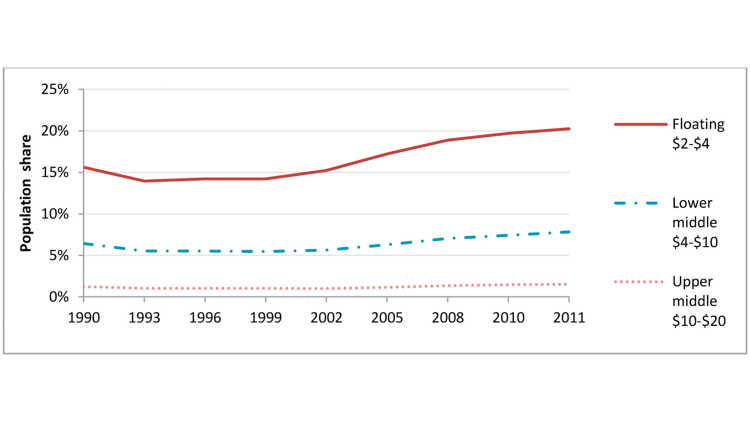
Apart from the discussion on the mere size and lived economic reality of Africa’s lower and upper middle classes, it is important to ask whether these definitions actually matter once we look beyond consumption. A number of researchers assume they do. For example, Mthuli Ncube suggests that the emerging middle class in Africa (USD 2–USD 20) “has the capacity [not only] to increase domestic consumption [but also to] contribute to private sector growth and entrepreneurialism; boost demand for better governance and public services; improve gender equality; and raise standards of living, allowing many people to exit from poverty” (Ncube and Lufumpa 2015: 1). Nancy Birdsall (2015) adopts a somewhat more restrictive perspective, viewing the lower middle class (USD 4–USD 10) – the members of which do not yet enjoy a similarly comfortable position in life as the secure upper middle class – as a political catalyst that can push for greater government accountability and good governance.
However, these studies’ over-reliance on monetary measures of class calls into question their expectations of middle-class attitudes. Any absolute or relative monetary threshold can hardly be understood as a strict division of the population into clearly distinct social groups.
Rather, from a sociological perspective, a fabric worker in a leading position and a trainee teacher may earn similar salaries but are unlikely to share common interests. Thus to ensure a more theoretically sound class analysis, there are studies that draw on the sociological literature to develop more complex definitions based on the ownership of tangible and intangible assets, employment status, occupation, education, or possibilities for upward mobility.
Hitherto, only few studies exist that take into account such factors and have sought to develop a more comprehensive measurement in order to assess the middle-class in sub-Saharan Africa. These studies have tended to focus on people’s consumption capacity and behaviour, or on asset status. Based on an asset-based methodology, one study scales down the number of Africans considered middle class to 19 million, amounting to 3.3 per cent of the adult population (Credit Suisse 2015). Another finds that while the middle class is growing in size on average, it is at a much slower rate than suggested by most of the income- or expenditure-based calculations (Shimeless and Ncube 2015). The study conducted by McEwan et al. (2015) is rare in that it employs a multidimensional indicator that differentiates consumers into 10 groups according to 29 indicators of living standards in South Africa (e.g. asset ownership, race, degree of urbanisation, etc.). Their findings reveal that upper sections of the middle class and the upper class (groups 7 to 10 according to their methodology) had grown rapidly in size and covered around 35 per cent of the South African adult population in 2011.
Taking these additional dimensions into consideration can be particularly important if one wishes to establish a link between class membership and political attitudes and behaviours. Following Inglehart’s hierarchy of needs, lower levels of economic scarcity and insecurity are necessary conditions for a shift in priorities towards higher-order “post-materialist” values such as self-expression, democracy, gender rights, and environmental concerns. For other modernisation thinkers, however, income growth by itself is not a sufficient condition; it only matters due to its close association with changes in education levels, which shapes social attitudes, or because it enables the middle class to act independently of the state. In the following we investigate the extent to which these concepts are prevalent in Africa.
Political Attitudes and Behaviour of Middle-Class Members in Africa
The question that inevitably arises is whether we are actually witnessing the emergence of a new, politically conscious African middle class that upholds civic values and democratic attitudes. While the academic evidence is still scare in this regard, more than a few media reports suggest that this is the case. Three core aspects have been connected to the political behaviour and attitudes of middle classes across different African countries:
Youth-led public protests shielding existing democratic systems
The past year kicked off with a series of upbeat news reports on a wave of protests that aimed to shield existing democratic systems from veteran leaders’ attempts to cling to power. Commentators attributed these youth-led street-level protests to the middle class – including those that resulted in the election of a new president in Burkina Faso, Senegal, Nigeria, and Benin, as well as those that failed to bring about a change in presidency, such as in Uganda. This assumption was based on the observations that the protests emerged in larger cities and that the spaces where political debates take place (e.g. pay-television news, talk radio stations, social media, and other online platforms) are generally inaccessible to society’s poorest. There is, however, insufficient evidence to support the assertion that these events were part of a middle-class movement. In most of the countries in question there is not a middle class large enough to have effected such changeovers in power. If anything, one may conclude that there is a frustrated, increasingly vocal, predominantly young, urban lower middle class that is interconnecting through social media networks and making their voices heard. After a decade of strong but largely jobless economic growth, sub-Saharan Africa’s young urban dwellers are at the crossroads between upward and downward mobility. Discontent over high unemployment rates and persistent inequality, rather than any joint middle-class identity, seems to be the driving force behind these protests.
Higher levels of education fostering support for democracy and civic values
A few recent academic studies have shown that, if defined mainly by higher levels of education, the middle class in sub-Saharan Africa is indeed more likely to uphold democracy as an ideal, be critical of long-serving African leaders, and prioritise higher-order needs than their less-educated peers. For example, according to the Afrobarometer opinion poll which asked Kenyans about their voting behaviour at the 2013 general election, middle-class Kenyans were found to be much more hesitant to strongly agree that the president should be free to act without constraints than their lower-class (less-educated) peers. They are also considerably less likely to approve a government’s right to unilaterally ban organisations it dislikes. And particularly important for the democratic landscape, while two in three highly educated Kenyans believe multi-partyism is needed in order to have a real choice in who governs them (68 per cent), every second uneducated Kenyan sees political parties as divisive or confusing (51 per cent) (Cheeseman 2014).
With respect to electoral authoritarian regimes, middle-class voter turnout has been commonly found to be higher the more competitive an election is perceived to be. For example, a study on Zimbabwe based on Afrobarometer data reveals that middle-class citizens (mainly defined by higher levels of education) have a higher level of political awareness but are less likely to participate politically if they believe that their votes are worthless or legitimate autocrats. For instance, better-educated citizens cast significantly more votes during the 2008 election, when opposition candidate Morgan Tsvangirai put up a credible challenge to incumbent president Robert Mugabe, than they did in 2013, when there was no serious opposition (Croke et al. 2015).
However, these findings hardly represent any middle-class particularism; rather, they justify the assumption of the positive and rather monotonic relationship between education and pro-democratic attitudes also found in other regions around the world. Similarly, researchers investigating the role of the middle class in democratic consolidation in the case of Zambia highlight that the largest difference in political participation, trust, and values is between the rich and the poor at the two extremes rather than between the middle class and the rest (Resnick 2015).
Class affiliation versus cultural and historic ties
Another underestimated aspect is the socio-cultural diversity of the new middle class. More than a few analysts believe that the middle class is more likely to vote according to actual policy preferences rather than to traditional allegiances to any party or ethnic group (e.g. Fletcher 2013). However, ethnicity and other historically determined loyalties still play important roles when it comes to voting. In fact, they frequently convey identity and shape behaviourism in more important ways than does class membership. A survey of young middle-class voters in the context of Kenya’s 2013 election revealed that “despite initially expressing a preference for candidates who stood for better governance and the fight against corruption, they ultimately voted for the party led by [incumbent president] Uhuru Kenyatta. As members of the Kikuyu ethnic group they worried that voting against Kenyatta’s broad but Kikuyu dominated ethnic coalition would allow a non-Kikuyu to win the Presidency” (Bernstein et al. 2014: 3).
Similar findings have been obtained in the case of South Africa, where racial differences within the middle class still dominate inter-class differences in political participation and public policy preferences (Mattes 2015). Researchers have specifically detected a lack of social identity among the middle class, which constrains its transformative potential. “If the racial gap in earnings and education is decreasing, but racial differences continue to loom large in the minds of South Africans, the growth in the black share of middle-class professions or the black share of income may not translate to a more integrated and less polarised social and political landscape” (Burger et al. 2015: 38). In the following section we will take a closer look at these historic ties in the specific case of South Africa.
The Case of South Africa: The Potential of the Middle Class to Take a Critical Stance in Politics
South Africa serves as an especially illustrative case of how the transformative power of the middle class may be connected to its relationship with the state. One could expect that post-apartheid policy tools like affirmative action, black economic empowerment, and state development contracts have drawn upwardly mobile black South Africans into a coalition with the ruling party. For example, “a black elite and middle class that has found itself in positions of power, privilege and profit is not likely to bite the hand of the party-state that feeds it” (Southall 2014). In fact, “The more dependent they are upon the ruling party for their welfare, the more they are likely to support it” (Ibid.). This situation would rather contradict the assumption that Africa’s middle class will become a strong agent of (pro-democratic) political change. Similar claims have been made with respect to the middle classes in India and Indonesia, for example, who are often characterised as too close to the state to actually assert political pressure (Handley 2015).
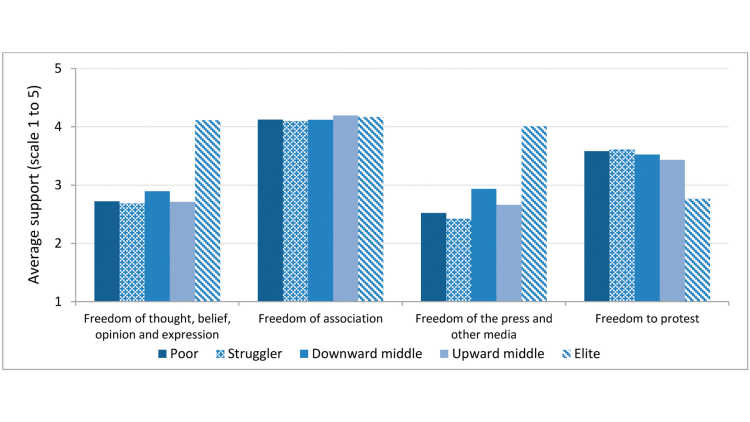
Nonetheless, recent evidence shows that South Africa’s black middle-class voters are actually less likely to identify with the ruling African National Congress (ANC) – which has governed the country since the end of apartheid in 1994 – and more likely to vote for the opposition than are other black South Africans. Furthermore, black South Africans who enjoy physiological security or have had access to higher education are more likely to support higher-order needs of good governance and self-expression and less likely to prioritise the provision of basic goods and services than are their worse-off peers (Mattes 2015). However, these findings may at least be partly driven by a very broad categorisation employed in this study, which lumps the middle class in with the elite.
In the following we use data from the 2012 South African Social Attitudes Survey (SASAS) to highlight that political attitudes within this broadly defined middle class are far from uniform and may depend not only on the present living standard but also on expectations of future well-being and perceived life chances. We suggest a multidimensional approach to defining “middle-class” – one that combines indicators of household wealth (assets), upward social mobility, and perceived well-being. This allows us to produce a finer subdivision that differentiates between five social classes: (i) the “poor,” who lead the most precarious lives, (ii) “strugglers,” who have just escaped poverty, (iii) a “downwardly mobile” middle class, (iv) an “upwardly mobile” middle class, and (v) the “elite.”[3]
As illustrated in Figure 3, the largest difference in average support for civil liberties in South Africa is not between the middle class, on the one hand, and the lower classes and the elite, on the other, but rather between the elite and the rest. The elite shows the strongest opposition to any government authority that allows it to prevent citizens from criticising the state or to control the information given to the public. The differences between the four non-elite classes are comparatively marginal. This raises the question of whether support for good governance is driven by the black elite alone and not, as found by Mattes (2015), by the new black middle class. At the same time, the elite is least likely to support mass protest as an acceptable way for people to express their views in a democracy.
Moreover, when looking at other policy areas, we find little support for the idea that the middle class will take a more critical stance in politics. On the contrary, better-off households are generally more satisfied with the provision of public infrastructure than are the poor, and the more upward mobile they are, the higher their satisfaction with the provision of other public services, including education, health care, and social grants (see Figure 4a). High satisfaction offers the middle class little reason to pressure the state to provide higher-quality public goods and services to everyone, especially the poorest. Figure 4b further suggests that particularly those who have climbed the social ladder under the current regime may exhibit a status quo bias, prioritising stability and safeguarding attained living standards over progress for the wider population (Schotte 2016).
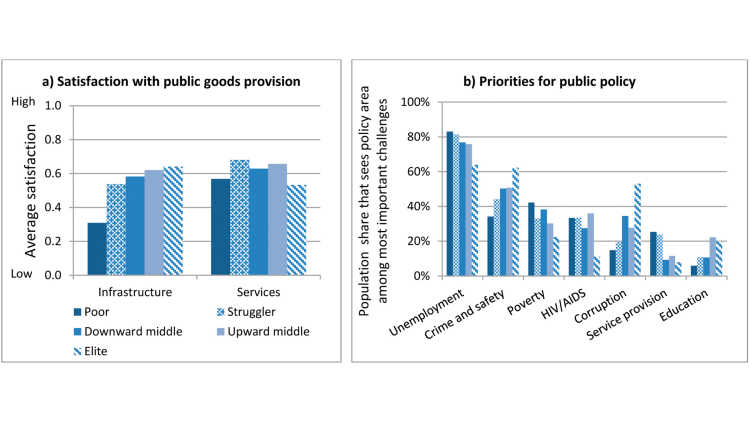
Whether South Africa’s political landscape is actually changing will be revealed at the 2016 municipal elections. Given that large parts of society are deeply frustrated with persistently high (racial) inequality, scarce jobs, and limited access to higher education, the ANC certainly cannot take for granted the new black middle-class constituency it helped to create. However, it would not be the first time that hopes for change have been dashed on election day. So far, the ANC has weathered all crises and scandals it has faced, performing just as well as it did in past elections (Botlhokwane 2016).
Fact and Fiction of Africa’s New Middle Class: Lessons for Policy-Making
After a decade of strong but largely jobless economic growth, the bulk of Africa’s new non-poor remain at the crossroads between upward and downward mobility and vulnerable to economic shocks. Fighting persistent inequality and expanding access to jobs and education are the most important issues that governments in the region will need to address to prevent strugglers from falling back into poverty as economic conditions deteriorate.
Despite these considerations, the link between the middle class and political attitudes is far from straightforward and depends, not least, on the type of definitions used to define “middle class” and its subclasses. Improved living standards and higher levels of education have been associated with pro-democratic attitudes and behaviour. Although these are not particular to the middle class, and the largest difference in political views is still between the poor and the elite, the growing share of people who fall between these two extremes has the potential to become a catalyst in Africa’s political landscape and challenge traditional power structures. Nevertheless, whether this so-called new middle class will actually engage in ways that are politically and economically transformative essentially depends on four conditions:
There needs to be a collective identity that transcends ethnic and racial divides and historic ties. Put differently, middle class Africans must share common interests and have the ability to collectively organise in pursuit of those interests (Handley 2015). Social media can play an important role, especially in connecting predominantly young and urban lower middle-class citizens, as youth-led street-level protests have shown. However, traditional power structures will generally remain in place as long as voting behaviour remains largely dominated by historic allegiances.
Support for good governance as an ideal must translate into political action for it to have an impact. If higher levels of education decrease political participation (or increase political apathy), especially in autocratic contexts, there is little reason to expect the new middle class to become a central force for democratic consolidation throughout the region. The transformative power of the middle class rests on its ability and disposition to act independently of the state and criticise the government where necessary. The more new middle-class members depend upon their respective ruling party for their welfare, the less likely they are to turn against it.
The interests of the middle class ought to at least be compatible with the needs of the broader population. Otherwise, there is a risk of politicians losing sight of the continuing importance of the fight against persistent poverty in Africa.
Meeting all four conditions will be quite demanding and not easily attained in a short period of time. As cautioned by Henning Melber, the high expectations placed on the middle class in terms of socio-political advancements are like “trusting those who row the galley to decide its course. Meanwhile, the captain and his adjuncts are navigating from the commanding bridge, not rowing at all” (Melber 2013: 118).
Fußnoten
Literatur
Bernstein, Ann, Sandy Johnston, Marius Roodt, and Stefan Schirmer (2014), The Middle Classes of India, Kenya and South Africa, edited proceedings of a Round Table convened by the Centre for Development and Enterprise, Johannesburg, March.
Birdsall, Nancy (2015), Does the Rise of the Middle Class Lock in Good Government in the Developing World?, in: European Journal of Development Research, 27, 2, 217–229.
Botlhokwane, Gopolang (2016), South Africa: Political Scandals Reveal the Great South African Disconnect between the Poor and Middle-Class, in: AllAfrica, 24 March, http://allafrica.com/stories/ 201603240744.html (28. March 2016).
Burger, Ronelle, Cindy L. Steenekamp, Servaas van der Berg, and Asmus Zoch (2015), The Emergent Middle Class in Contemporary South Africa: Examining and Comparing Rival Approaches, in: Development Southern Africa, 32, 1, 25–40.
Cheeseman, Nic (2014), Does the African Middle Class Defend Democracy?, WIDER Working Paper, 96, Helsinki: World Institute for Development Economics Research.
Credit Suisse (2015), Global Wealth Report 2015, Zurich: Credit Suisse Research Institute.
Croke, Kevin, Guy Grossman, and Horacio A. Larreguy (2015), Deliberate Disengagement: How Education Decreases Political Participation in Electoral Authoritarian Regimes, Afrobarometer Working Paper, 156.
Fletcher, Pascal (2013), Africa’s Emerging Middle Class Drives Growth and Democracy, in: Reuters, 10 May, www.reuters.com/article/us-africa-investment-idUSBRE9490DV20130510 (28. March 2016).
Handley, Antoinette (2015), Varieties of Capitalists? The Middle–Class, Private Sector and Economic Outcomes in Africa, in: Journal of International Development, 27, 5, 609–627.
Kharas, Homi (2010), The Emerging Middle Class in Developing Countries, Working Paper, 285, Paris: OECD Development Centre.
Mattes, Robert (2015), South Africa’s Emerging Black Middle Class: A Harbinger of Political Change?, in: Journal of International Development, 27, 5, 665–692.
McEwan, Cheryl, Alex Hughes, and David Bek (2015), Theorising Middle Class Consumption from the Global South: A Study of Everyday Ethics in South Africa’s Western Cape, in: Geoforum, 67, 233–243.
Melber, Henning (2013), Africa and the Middle Class(es), in: Africa Spectrum, 48, 3, 111–120, http://journals.sub.uni-hamburg.de/giga/afsp/article/view/679/677 (26 April 2016).
Ncube, Mthuli, Charles Leyeka Lufumpa, and Steve Kayizzi-Mugerwa (2011), The Middle of the Pyramid: Dynamics of the Middle Class in Africa, Tunis: African Development Bank.
Ncube, Mthuli, and Charles Leyeka Lufumpa (eds) (2015), The Emerging Middle Class in Africa, New York, NY: Routledge.
Resnick, Danielle (2015), The Middle Class and Democratic Consolidation in Zambia, in: Journal of International Development, 27, 5, 693–715.
Schotte, Simone (2016), Not Middle Class, but Middle Classes: An Assessment for South Africa, paper prepared for presentation at the International Workshop on Inequality and Middle Class Development in Africa, Cape Town, 4–6 May.
Shimeles, Abebe, and Mthuli Ncube (2015), The Making of the Middle-Class in Africa: Evidence from DHS Data, in: The Journal of Development Studies, 51, 2, 178–193.
Southall, Robert (2014), The Black Middle Class and Democracy in South Africa, in: Journal of Modern African Studies, 52, 34, 647–670.
Gesamtredaktion GIGA Focus
Redaktion GIGA Focus Afrika
Lektorat GIGA Focus Afrika
Regionalinstitute
Forschungsschwerpunkte
Wie man diesen Artikel zitiert
Giesbert, Lena, und Simone Schotte (2016), Afrikas neue Mittelschicht: Fakten und Fiktionen ihrer transformativen Kraft, GIGA Focus Afrika, 1, Hamburg: German Institute for Global and Area Studies (GIGA), http://nbn-resolving.de/urn:nbn:de:0168-ssoar-46770-2
Impressum
Der GIGA Focus ist eine Open-Access-Publikation. Sie kann kostenfrei im Internet gelesen und heruntergeladen werden unter www.giga-hamburg.de/de/publikationen/giga-focus und darf gemäß den Bedingungen der Creative-Commons-Lizenz Attribution-No Derivative Works 3.0 frei vervielfältigt, verbreitet und öffentlich zugänglich gemacht werden. Dies umfasst insbesondere: korrekte Angabe der Erstveröffentlichung als GIGA Focus, keine Bearbeitung oder Kürzung.
Das German Institute for Global and Area Studies (GIGA) – Leibniz-Institut für Globale und Regionale Studien in Hamburg gibt Focus-Reihen zu Afrika, Asien, Lateinamerika, Nahost und zu globalen Fragen heraus. Der GIGA Focus wird vom GIGA redaktionell gestaltet. Die vertretenen Auffassungen stellen die der Autorinnen und Autoren und nicht unbedingt die des Instituts dar. Die Verfassenden sind für den Inhalt ihrer Beiträge verantwortlich. Irrtümer und Auslassungen bleiben vorbehalten. Das GIGA und die Autorinnen und Autoren haften nicht für Richtigkeit und Vollständigkeit oder für Konsequenzen, die sich aus der Nutzung der bereitgestellten Informationen ergeben.




